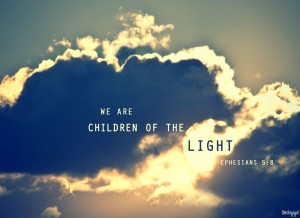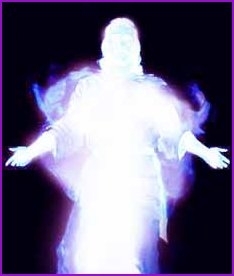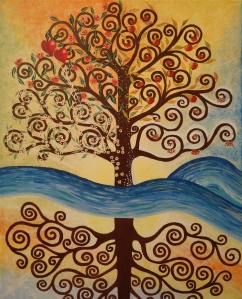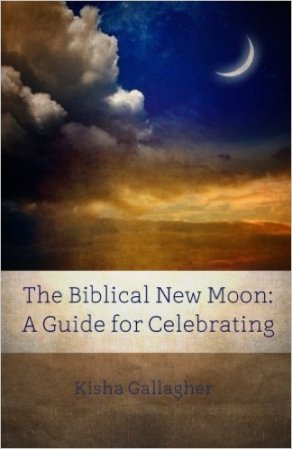 And the man and his wife were both naked and were not ashamed. (Gen. 2:25 NASB).”In the beginning, man and woman were “naked” and not ashamed. The Hebrew word for naked in the above verse is arom (ayin, rosh, mem). It comes from the verbal root aram (same Hebrew letters as arom), which means, “to make bare, to be subtle, crafty, or cunning.”[1] This is interesting because in the next chapter of Genesis, actually in the very next verse on the scroll, the serpent is introduced. He is more subtle, crafty, or cunning that any BEAST of the field that YHWH had made.
And the man and his wife were both naked and were not ashamed. (Gen. 2:25 NASB).”In the beginning, man and woman were “naked” and not ashamed. The Hebrew word for naked in the above verse is arom (ayin, rosh, mem). It comes from the verbal root aram (same Hebrew letters as arom), which means, “to make bare, to be subtle, crafty, or cunning.”[1] This is interesting because in the next chapter of Genesis, actually in the very next verse on the scroll, the serpent is introduced. He is more subtle, crafty, or cunning that any BEAST of the field that YHWH had made.
Now the serpent was more crafty than any beast of the field which the LORD God had made. And he said to the woman, “Indeed, has God said, ‘You shall not eat from any tree of the garden’?” (Gen. 3:1)
As I’m sure you have guessed, the Hebrew word used to describe the serpent as crafty is from the same Hebrew word above. It is the passive participle form of aram, pronounced arum (again same Hebrew letters as arom).[2] Thus, like many Hebrew words, arom is actually a contranym (a word that is its own opposite).[3] To be naked is akin to being transparent with nothing hidden. On the contrary, to be cunning or crafty, something is definitely hidden or concealed.
In the case of Adam and Chavah (Eve) before the fall, their nakedness wasn’t something in which they should be ashamed. They were transparent with nothing to hide. Their nakedness was virtuous at this point. They had no need of being covered in the hair of a beast, nor did they need a covering of fur for protection. (Obviously, the converse was true for the serpent, but we explore him in a later post.)
Skins of Light
There are traditions from both Jewish and Christian sources that teach that before the fall, the skin of Adam and Chavah was luminous. In other words, they were “covered” by divine light and would “glow,” so to speak. I hope this triggers your mind to make some connections to Moses’ face and Messiah, but we will get there soon enough.
 This idea or tradition isn’t random. The Hebrew language is VERY idiomatic, metaphoric, and figurative. Contranyms, homonyms (sound alike words), parables, and many other literary devices are used heavily to help one understand spiritual concepts through the experience of natural things.[4] Hebrew speaks through our senses and imagination. It draws simple “pictures” that even a child can understand. As the old adage goes, “a picture is worth a thousand words.” In our case, it is neither coincidence nor chance that the Hebrew word for light and for skin sound exactly the same: ohr. Look carefully at the following:
This idea or tradition isn’t random. The Hebrew language is VERY idiomatic, metaphoric, and figurative. Contranyms, homonyms (sound alike words), parables, and many other literary devices are used heavily to help one understand spiritual concepts through the experience of natural things.[4] Hebrew speaks through our senses and imagination. It draws simple “pictures” that even a child can understand. As the old adage goes, “a picture is worth a thousand words.” In our case, it is neither coincidence nor chance that the Hebrew word for light and for skin sound exactly the same: ohr. Look carefully at the following:
אוֹר Light (aleph, vav, resh)
עוֹר Skin (ahyin, vav, resh)
The only difference is the first letter (read from right to left). Light begins with aleph, a letter heavily associated with God,[5] and skin begins with ahyin, the letter that also means eye. Both aleph and ahyin are silent letters. They have no sound aside from the vowel associated with them. In our words above, the vowel is shown by the letter vav with the dot on top, which is called a cholem vav. The last letter is a resh, an “r” sound that pictographically means “a man’s head.”
By simply looking at the pictographic meaning of these words, both have a heart that connects. Vav means to link, connect, or hook together. It is also the number 6, the creation day for both beast and man. In the verses above in Genesis, the text presents us with a beast (snake) that speaks like a man.
The other Hebrew letters for each word reveals what light and skin connects or links one with. In the case of light, the head (resh) is connected to God (aleph), the Father. But in the case of skin, the head (resh) is connected to only what one’s eyes (ahyin) can see (flesh/natural).
Dr. Alewine in The Creation Gospel Workbook Four: The Scarlet Harlot and the Crimson Thread has this to say:
“Rabbinic insight is that the clothing of Adam and Eve was glory, or radiance (or with an aleph), a white light invisible to the human eye that was replaced with a covering of skins (or with an ayin). The white light is the same covering of the Bride of Messiah in Revelation. The Bride reflects the Lamp of the New Jerusalem, the Lamb. In terms of the menorah, there was a spiritual covering over the first couple’s earthly bodies, a covering or radiance pictured when Moses spoke with Adonai on the mountain, receiving the Torah covenant for Israel. Like the Holy One in whose image they were made, they had corresponding covers of light like garments.” (p. 175)
Roaming Eyes
Do you recall what organ tempted Chavah (Eve) to fall into deception?
The serpent said to the woman, “You surely will not die! “For God knows that in the day you eat from it your eyes will be opened, and you will be like God, knowing good and evil.” (Gen. 3:4-5)
The serpent, the one that was arum (cunning), was implying that Adam and Chavah were “blind” in some way. Recall, that at this point, Adam and Chavah were naked, arom, but had no shame. Before sin, their covering was the spiritual light of Elohim (God). Again, notice below the association with EYES.
When the woman saw that the tree was good for food, and that it was a delight to the eyes, and that the tree was desirable to make one wise, she took from its fruit and ate; and she gave also to her husband with her, and he ate. Then the eyes of both of them were opened, and they knew that they were naked; and they sewed fig leaves together and made themselves loin coverings. (Gen. 3:6-7)
Chavah SAW the Tree of Knowledge of Good and Evil and found that it delighted her eyes, and had the potential to make one WISE. Folks, our eyes are what typically deceive us. Imagine with me all the sins that begin by looking at someone or something with our eyes: coveting, jealousy, lust, greed, envy, judgment, false witness or testimony, etc. It has been this way since the beginning. Our eyes can be deceitful because they are a part of our flesh/nephesh. They need a constant physical and visual reminder that will refocus our attention back to the heavenly and spiritual reality. This is one reason YHWH gave the commandment to wear tzit-tziyot (fringes) on the four corners of one’s garments. Again, notice the EYES.
“It shall be a tassel for you to look at and remember all the commandments of the LORD, so as to do them and not follow after your own heart and your own eyes, after which you played the harlot, so that you may remember to do all My commandments and be holy to your God. (Num. 15:39-40)
Leaves that Kill, Leaves that Heal
When Adam and Chavah ate from the Tree of Knowledge, they forfeited the Light (of God) as their covering. In other words, they took upon themselves a different authority. Once they transgressed YHWH’s command, they immediately realized that their heavenly garments were missing. They were “bare” or naked without this covering (of light). Like them, we would probably scramble to find a replacement for such a great loss. In fact, this realization is what caused them to fear, and it is the reason they hid from Elohim. (Gen. 3:8)
 So, why do you think they chose fig leaves? I believe that prior to sin, the Tree of Life provided Adam and Chavah with their garments or skins of Light. Often used as an idiom for the Torah or Law of God and Wisdom, the Tree of Life indeed produces light, life, healing, fruit, and blessings. I encourage you to do a concordance search and find your own associations.
So, why do you think they chose fig leaves? I believe that prior to sin, the Tree of Life provided Adam and Chavah with their garments or skins of Light. Often used as an idiom for the Torah or Law of God and Wisdom, the Tree of Life indeed produces light, life, healing, fruit, and blessings. I encourage you to do a concordance search and find your own associations.
Then he showed me a river of the water of life, clear as crystal, coming from the throne of God and of the Lamb, in the middle of its street. On either side of the river was the tree of life, bearing twelve kinds of fruit, yielding its fruit every month; and the leaves of the tree were for the healing of the nations. (Rev. 22:1-2)
The leaves from the Tree of Life HEALS the nations. Perhaps, Adam and Chavah thought that the leaves from the Tree of Knowledge (their new tree of choice) would do the same. But what they discovered is that the Tree of Knowledge of Good and Evil only leads to darkness, exile, death, sickness, fleshly desires, and curses. It is the exact antithesis to the Tree of Life. So what did God do?
The LORD God made garments of skin (ohr) for Adam and his wife, and clothed them. (Gen. 3:21)
What Kind of Skin?
We typically assume that God slaughtered an animal and made coverings of fur for the first couple. But the text doesn’t explicitly say that this is what God did. There is no mention of Him slaughtering an animal. Our old assumption isn’t necessarily wrong, but the skin (ohr) that God made could have been of (mortal) human skin. The verse literally says that God made (asah) ohr (skin) and clothed Adam and Chavah with it. Perhaps, after losing their garments of Light, God made them garments of (mortal human) skin. This is a viable possibility in the Hebrew and one to consider.
Whether or not Adam and Chavah once had literal garments of Light that were forfeited when they sinned isn’t the point. God did make for them skins (human or animal) in which to cover their nakedness. Maybe their nakedness wasn’t physical. Or perhaps, it was both physical and spiritual. Either way, this series will explore the figurative or spiritual side of this coin.
Much more to explore in upcoming articles. Click here for Part II…
[1] See Strong’s definitions for H6174 and H6191.
[2] H6175
[3] A contranym (also spelled contronym) is sometimes called an auto antonym. Like Hebrew, the English language has many terms that fall into this category. Think of the word cleave. It can mean to cling to tightly or to cut into as to divide into pieces. Other examples are as follows:
Bolt: To secure, or to flee
Bound: Heading to a destination, or restrained from movement
Buckle: To connect, or to break or collapse
Clip: To fasten, or detach
Screen: To present, or to conceal
Splice: To join, or to separate
Transparent: Invisible, or obvious
[4] 1 Cor. 15:46
[5] This is based on the many words that begin with aleph: for example, Elohim, Abba, El, etc. Moreover, the ancient Hebrew pictograph means a strong leader, strength, power, ox, etc.
For more great insight into the first couple and the serpent in the garden, please see Rabbi David Fohrman’s book, The Beast that Crouches at the door.





Guard your eyes! very insightful (no pun intended). I had not thought of the significance of what comes through our eyes. thank you!
LikeLiked by 1 person
Thanks for your comment. 😊 Eyes are quite a fascinating topic in Scripture (metaphorically speaking). Which by the way, made me enjoy your pun all the more! Lol.
LikeLiked by 1 person
Thank you for this post! This such an interesting topic. It is amazing to see the Hebrew word connection between skin and light! I look forward to your series. I have thought about this subject of ‘garments.’ Since we are created in Father’s image, and since His garments are so beautiful and majestic (Psa 93:1; Psa 104:1,2), it seems to me that us human beings ought to wear garments of elegance and modesty, reflecting honor and respect for our Creator. Perhaps you have thought about this too. Anyway, it is so nice to see that you will be discussing this subject.
Blessings, Deborah
LikeLiked by 1 person
Thanks Deborah! I’ve been out of town, thus the late reply. 😊 I agree; our garments should reflect the Almighty. Part 2 should publish this week.
LikeLike
Pingback: Garments of Light Part II | GRACE in TORAH
Thanks. This is very well written; giving me food for thought. =)
LikeLiked by 1 person
Pingback: What Do Costumes Have to Do With the Book of Esther? | GRACE in TORAH